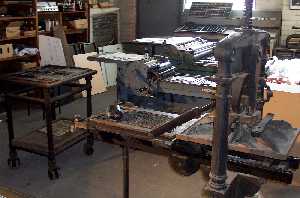![Melbourne Museum of Printing [36pt Old English]](../../-pix/mmolde36.gif)

P.O. BOX 555, FOOTSCRAY 3011 - - - - - - - - - - - - - (03)9689 7555
 OUR WEB PAGE: www.BalanceResearch.com/museum/
OUR WEB PAGE: www.BalanceResearch.com/museum/
THE WORLD'S GREATEST MUSEUM OF PRINTING, PUBLISHING AND
PACKAGING
| AIMS | SERVICES | VALUES | AUDIENCES |
ARTEFACT COLLECTION |
The Museum's temporary closure since 1998 has foiled wide recognition
of its collection and programs. It may therefore be a surprise to hear
that it is potentially the world's most comprehensive Museum in its
field. This view has been strengthened after hearing recently from
overseas experts that there really is no other collection like it in
the world, nor are its unique proposed programs offered anywhere.
Provided that support is forthcoming for its re-establishment,
the Museum of Printing will be in full swing well before the
2006 Commonwealth Games. It will be a source of pride for
Victoria, for Australia and for those who have supported it.
THE AIMS OF THE MUSEUM INCLUDE :
-
More of the community will come to an understanding of the
role of printing in the development of society.
-
Those studying current printing and design techniques, or
working in these areas, will gain an appreciation of what
came before (and see the links between old and new).
-
And those who research the history of industry, society,
design, et al, will access our vast collection of printers'
artefacts and equipment.
The Melbourne Museum of Printing, when re-established, will be
one of the major printing museums of the world. Its educational
and artistic programs will set it apart from any other, and the
depth of its collection of artefacts will provide unequalled
opportunities for research.
This Museum, under its present name or some other name, will
fulfil a national role as the repository of equipment, artefacts
and understandings of the past and present industry of printing,
packaging and publishing. Establishment of a second campus
(possibly in Sydney) will be a possibility at a later stage.
|
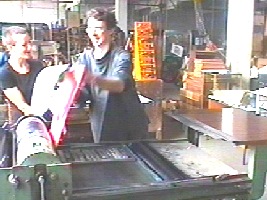
The community can come to an understanding of printing.
|
THE MUSEUM'S SERVICES
Once the Museum is re-established it will offer a wide range of
services. These include:
-
Educational workshops for secondary, TAFE and university
students with an interest in typography, as well as those
already working in printing and design;
-
Research opportunities for scholars in the practice and
history of graphic design, society, commerce, industry,
engineering and other fields;
-
General visitation including school groups (non-workshop),
citizens clubs and tourists;
-
Facilities for artists and writers to practice printmaking
with metal types and hand presses;
-
Provision of props and locations for film makers. The Museum
supplied equipment and specialist advice for "Pozieres" and
"My Brother Jack", among others.
Most of these features are unique in Australia and some, it would
seem, are unique in the world.
The Museum will also continue to provide support for other
institutions (museums, theme parks, university departments) who
have printing equipment in their collections and need otherwise
unavailable advice and supplies (such as founts of handset type).
REACHING THE INDUSTRY AND THE PEOPLE
|
Preserving the past of printing and publishing is a worthwhile
venture and the Museum will reach a wide and continuing audience.
The museum will provide many benefits to the community. There is
little doubt that it will attract industrial support, and through
its internal and outreach programs, it will also be a link from
its major benefactors to the wider public and to all those
involved in printing, publishing and design whether as students
or working.
People in the film-making industry are among those who have used
and appreciated the Museum's range of machinery and equipment.
They have not yet taken advantage of the complete, workable
composing room with a realistic battery of Linotypes, but they
will. They will come from around the world to see it and use it.
Any organisation which takes the initiative in restarting, or at
least protecting, this Museum will have good reason to be proud
of it.
|
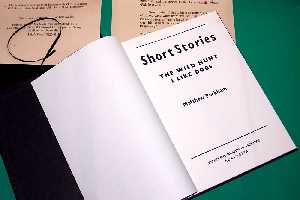
Fine art, like this limited edition book, carry the Museum's imprint
around the world.
|
THE VALUES OF THE MUSEUM OF PRINTING
The Museum claims that, through its collections and its programs,
it will have a number of benefits for Victoria. It will benefit
those who may come from interstate and overseas and that will of
course also benefit Victoria.
-
In artistic terms, it has values in printmaking, art
education, art and design history, support for other museums
and users of older technology and film makers.
-
In heritage terms it has values in conservation of
industrial processes and knowledge and the world's only
trove of printers' work-in-progress.
-
In educational terms it has values in showing the
development of printing to students in typography,
technology, society and history. "Development" includes the
industry of printing, the design of printing and the effects
of printing.
-
In terms of tourism, when successfully established, it will
attract (at least) reasonable numbers of general public,
school groups, citizens groups and incoming tourists. It
will provide opportunities for employment and volunteering.
The Museum, in its former location, was never open to the public
but ran its artist access studio and the "Graphic Students'
Workshop" (GSW). The access studio was used by many printmaking
artists to print works they could not do anywhere else. There are
few such facilities in the world.
The GSW ran on a pilot basis and proved that teachers were keen
to bring their students and willing to pay a substantial fee to
see the link between traditional printing and what they do today
in software.
THE MUSEUM'S AUDIENCES
|
The main audiences of the Museum's programs will include:
-
the general public who will gain an understanding of the
role of printing in development of knowledge and society;
-
those working in, or studying for design and print, who will
see the connections between their computer software and what
came before and be able to preserve the associated skills;
-
artists and writers who would like to typeset and print by
hand their books, broadsheets and other works of art;
-
academic researchers whose work in the history of design,
industry, commerce, etc will benefit from our unique and
extensive resources of engravings, standing jobs and
documents relating to the work of many printers and their
thousands of clients since about 1950.
|
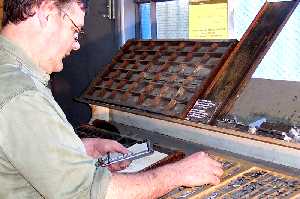
Visiting artist practices hand typesetting.
|
THE UNIQUE COLLECTION OF ARTEFACTS
|
There seems to be no other city, no other country, in which a
substantial cross section, some decades' worth, of printing jobs have
been preserved for research.
This Museum's collection of "documentary artefacts" consists of
the actual printing blocks and typesettings used for thousands of
printing jobs, from some dozens of printers in Victoria and elsewhere.
The artefacts cover almost every kind of general printing dating from
the 1960's to the 1990's with some earlier. They are accompanied by a
collection of job-related documents such as quotations, invoices,
proofs, job bags and specimens, and business related documents like
purchase orders and supplier invoices.
|
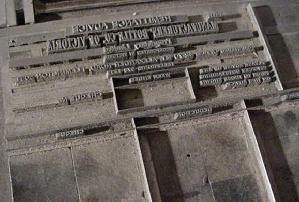
A preserved typesetting: fascinating.
|
|
